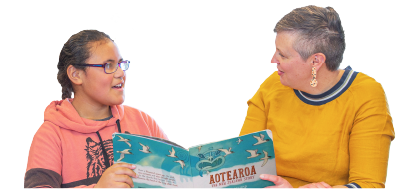Connecting with the community
Show video transcript
Title slide: Connecting with the community
Gary Roberts, Principal, Hornby Primary School, Christchurch, facing camera
If you ever have the opportunity to participate in someone's, sort of like, their backyard – it could be at church, it could be in sporting, or it could be, you know, when you invite parents to school over food, song, dance, whatever. So if you ever have an opportunity to engage Pacific families in their own setting you'll get great value out of it.
As a school, we put ourselves to the community to express our desire to be the school for the community. And to make that work we need to understand the community, and it means we've got to keep upskilling ourselves with what the community is and what makes them tick, you know, what they’re made up of and what they need to know and need to learn and what some of the trends that might be going through the community are.
It's a matter of having people who are in the community when we get an opportunity to appoint somebody. Certainly, it's advantageous to appoint people who know the community, whether they’re living in the community, whether they’re parents in the community, whether they’re former students. So it's a matter of putting together, you know, an overall strategy where you value the community and what opportunities you've got to ask the community, to engage the community, to work in with local church groups perhaps or local sports groups.
Children in the playground
It's a matter of being connected with the community and having your finger on the pulse of what's happening in the community, so that we can make sure that we work with them providing programmes, providing support, sharing what they need to know because we are that hub in the community. We’re that non-denominational hub where we facilitate learning opportunities that are meaningful, that are future-focused, that are inspirational.
Phil Muir, Principal, Northcote Intermediate, Auckland, facing camera
We need to know what the community wants. We need to know what the community is, how they're changing if they're changing so that we can respond to that appropriately. To be relevant and meaningful to the future of this country, we need to be relevant and meaningful to our community that we serve.
Today’s a good example of a project, for want of a better word, where we have a range of organisations coming together at the school to let students learn about themselves. Today's project is centred around... it came about with the Pacific Assist Trust, where we made a connection. They provide furniture, they take surplus furniture and send it to schools up in the Pacific Islands. So we went through that stage a couple of weeks ago where we had some surplus furniture that we weren’t going to use and wasn't going to be used for the foreseeable future. We knew there were people out there that would benefit from it.
So we're linking a range of organisations together across the community, presenting to students what it's all about, so they’re learning about what a project can look like to make a big change to a person or to a community of people, and then they’re part of it.
This video is about community engagement. It is about establishing strong home-community partnerships where parents, whānau, and communities are involved in and support learning. The narratives in the video emphasise how important it is for schools to know their community, know how their communities are changing and to that change to remain relevant and meaningful in their engagement. Connections are important, and an example in the video describes a project that involved an external organisation, the Pacific Assist Trust. The school and students collaborated with the trust to provide furniture for schools in the Pacific Islands. Linking external organisations to the school and giving them the opportunity to present to learners is what community connections are all about.
Reflections for individual teachers
Engaging with the local and wider community helps build learning partnerships. As you watch this video, think about your classroom-community partnerships.
- How are you designing your local curriculum to respond to the needs of your learners’ communities? How can you apply community knowledge to enhance learners’ learning?
- How do you go about forming and developing partnerships with your local community?
- Learners carry knowledge about their families and communities inside themselves. How will you ensure that your learners share this knowledge to support the development of their identities?
- Have you considered community homework in your class? What activities have you incorporated to establish community connections in your class learning? How do you foster these connections to expand your learners’ understanding by connecting with their community?
Reflections for staff or departments
Community engagement is one of eight principles in The New Zealand Curriculum that provides a foundation for schools' decision making. As you watch this video, as a staff member or a member of department staff, consider:
- How is your school engaging and connecting with your local community? How are you currently exploring, and connecting with, your local community and community organisations?
- Does your school have a culturally relevant strategy to engage with diverse communities and external organisations? If no, will you consider developing one? If yes, share what you know about your school’s engagement strategy.
- How often does your school conduct community research to increase connections? How can your school find out more about communities and organisations in your area?
- What other ways can your school bring your local community together to support school-community interactions and build on those connections?

